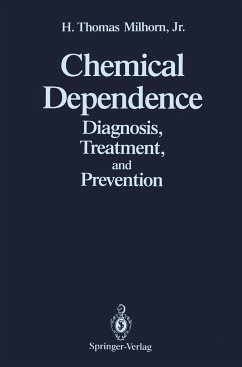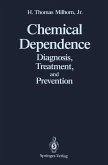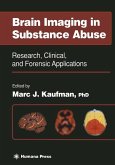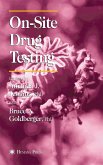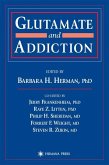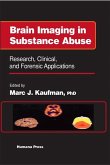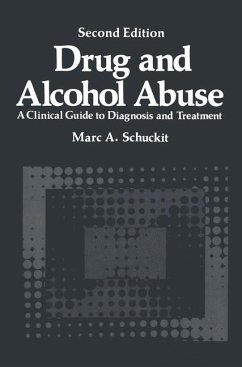Schade – dieser Artikel ist leider ausverkauft. Sobald wir wissen, ob und wann der Artikel wieder verfügbar ist, informieren wir Sie an dieser Stelle.
- Gebundenes Buch
- Merkliste
- Auf die Merkliste
- Bewerten Bewerten
- Teilen
- Produkt teilen
- Produkterinnerung
- Produkterinnerung
The author has organized basic, core information on the diagnosis, treatment and prevention of chemical dependence into a readily understandable format. His approach teaches the physician what steps to take from a practical point of view: how to prevent addiction in the first place, how to diagnose the condition, how to aid the family get the addict into treatment, and how to increase the chances of long-term recovery. The book is divided into three sections. The first section covers basic definitions and concepts. The second section describes the pharmacology of the various psychoactive…mehr
Andere Kunden interessierten sich auch für
![Chemical Dependence Chemical Dependence]() H. Thomas MilhornChemical Dependence41,99 €
H. Thomas MilhornChemical Dependence41,99 €![Beating Drug Tests and Defending Positive Results Beating Drug Tests and Defending Positive Results]() Amitava DasguptaBeating Drug Tests and Defending Positive Results85,99 €
Amitava DasguptaBeating Drug Tests and Defending Positive Results85,99 €![Brain Imaging in Substance Abuse Brain Imaging in Substance Abuse]() Brain Imaging in Substance Abuse173,99 €
Brain Imaging in Substance Abuse173,99 €![On-Site Drug Testing On-Site Drug Testing]() Amanda J. Jenkins / Bruce A. Goldberger (eds.)On-Site Drug Testing131,99 €
Amanda J. Jenkins / Bruce A. Goldberger (eds.)On-Site Drug Testing131,99 €![Glutamate and Addiction Glutamate and Addiction]() Barbara H. Herman (ed.)Glutamate and Addiction163,99 €
Barbara H. Herman (ed.)Glutamate and Addiction163,99 €![Brain Imaging in Substance Abuse Brain Imaging in Substance Abuse]() Marc J. Kaufman (ed.)Brain Imaging in Substance Abuse157,99 €
Marc J. Kaufman (ed.)Brain Imaging in Substance Abuse157,99 €![Drug and Alcohol Abuse Drug and Alcohol Abuse]() Marc A. SchuckitDrug and Alcohol Abuse42,99 €
Marc A. SchuckitDrug and Alcohol Abuse42,99 €-
-
-
The author has organized basic, core information on the diagnosis, treatment and prevention of chemical dependence into a readily understandable format. His approach teaches the physician what steps to take from a practical point of view: how to prevent addiction in the first place, how to diagnose the condition, how to aid the family get the addict into treatment, and how to increase the chances of long-term recovery. The book is divided into three sections. The first section covers basic definitions and concepts. The second section describes the pharmacology of the various psychoactive substances: depressants, opioids, stimulants, cannabinoids, hallucinogens, phencyclidines, and inhalants. The third section discusses chemical dependence in special groups: women, adolescents, the elderly, ethnic minorities, dual diagnosis patients, HIV- positive patients, and impaired physicians.
Produktdetails
- Produktdetails
- Verlag: Springer, Berlin
- 1990.
- Seitenzahl: 370
- Erscheinungstermin: 8. Oktober 1990
- Englisch
- Abmessung: 242mm x 162mm x 23mm
- Gewicht: 720g
- ISBN-13: 9780387972923
- ISBN-10: 0387972927
- Artikelnr.: 27660423
- Herstellerkennzeichnung
- Libri GmbH
- Europaallee 1
- 36244 Bad Hersfeld
- gpsr@libri.de
- Verlag: Springer, Berlin
- 1990.
- Seitenzahl: 370
- Erscheinungstermin: 8. Oktober 1990
- Englisch
- Abmessung: 242mm x 162mm x 23mm
- Gewicht: 720g
- ISBN-13: 9780387972923
- ISBN-10: 0387972927
- Artikelnr.: 27660423
- Herstellerkennzeichnung
- Libri GmbH
- Europaallee 1
- 36244 Bad Hersfeld
- gpsr@libri.de
1. Introduction.- The Problem.- Basic Definitions.- Progression to Chemical Dependence.- Denial.- Etiology of Chemical Dependence.- Classification of Drugs by Their Effects on the Central Nervous System.- Controlled Substance Act Classification of Drugs.- I The Basics.- 2. Diagnosis.- Problems in Diagnosis.- Making the Diagnosis.- Presenting the Diagnosis.- Final Comments.- 3. Treatment.- Getting the Addict into Treatment.- Treatment Options.- Choosing a Treatment Program.- Aftercare.- Confidentiality.- The Role of the Referring Physician.- Comment.- 4. Recovery and Relapse.- Recovery.- Relapse.- Methadone Maintenance.- The Role of the Physician.- 5. The Family.- The Healthy Family.- The Alcoholic Family.- Getting the Alcoholic Sober.- Getting the Family Well.- The Family in Recovery.- Adult Children of Alcoholics (ACOAs).- The Role of the Physician.- 6. Prevention.- Primary Prevention.- Prevention of Prescription Drug Abuse.- The Role of the Physician.- II Psychoactive Substances.- 7. Basic Principles of Pharmacology.- Pharmacokinetics.- Pharmacodynamics.- Tolerance.- Physical Dependence and Abstinence Syndrome.- 8. CNS Depressants: Alcohol.- History.- Pharmacology.- Alcoholism.- Diagnosis and Management.- Methyl Alcohol and Ethylene Glycol Toxicity.- 9. CNS Depressants: Barbiturates, Barbiturate-like Drugs,Meprobamate, Chloral Hydrate, Paraldehyde.- Barbiturates.- Barbiturate-like Drugs.- Meprobamate.- Chloral Hydrate.- Paraldehyde.- 10. CNS Depressants: Benzodiazepines.- History.- Pharmacology.- Health Consequences of Benzodiazepine Abuse.- Diagnosis and Management.- 11. Opioids.- Pharmacology.- Medical Uses and Contraindications.- Specific Opioid Drugs.- Health Consequences of Opioid Abuse.- Diagnosis and Management.- 12. CNS Stimulants: Amphetamines, Amphetamine Cogeners,Caffeine, Others.- Amphetamines.- Amphetamine Cogeners.- Caffeine.- Other CNS Stimulants.- 13. CNS Stimulants: Cocaine.- History.- Pharmacology.- Health Consequences of Cocaine Abuse.- Diagnosis and Management.- 14. CNS Stimulants: Nicotine.- History.- Trends in Cigarette Smoking.- Pharmacology.- Health Consequences of Nicotine Abuse.- Management.- Prevention.- Role of the Physician.- Other Forms of Tobacco Use.- 15. Cannabinoids.- History.- Pharmacology.- Therapeutic Uses.- Health Consequences of Marijuana Abuse.- Diagnosis and Management.- 16. Hallucinogens.- The Hallucinogens.- LSD.- Other Hallucinogenic Drugs.- 17. Phencyclidines.- History.- Pharmacology.- Health Consequences of PCP Abuse.- Diagnosis.- Management.- Emergence Phenomenon.- 18. Inhalants.- History.- The Inhalants.- Tolerance.- Dependence.- Abstinence Syndrome.- Diagnosis.- Management.- III Special Groups.- 19. Women.- Alcohol.- Other Drugs.- Fertility.- Diagnosis.- Treatment.- The Pregnant Addict.- The Fetus.- The Role of the Physician.- 20. Adolescents.- The Normal Adolescent.- The Substance Abuse Problem.- Why Adolescents Use Drugs.- The Chemically Dependent Adolescent.- Diagnosis of Adolescent Chemical Dependence.- Intervention.- Treatment.- Aftercare.- Role of the Physician.- 21. The Elderly.- Pathophysiology of Aging.- The Elderly Addict.- Diagnosis.- Treatment.- Aftercare.- Role of the Physician.- 22. Ethnic Minority Groups.- Definitions.- Ethnic Groups.- Diagnosis.- Treatment.- Role of the Physician.- 23. The Dual-Diagnosis Patient.- Primary Versus Secondary Psychiatric Disorders.- Primary Psychiatric Disorders.- Secondary Psychiatric Disorders.- Diagnosis.- Treatment.- DSM-III-R Classification System.- Role of the Physician.- 24. The HIV-Positive Patient.- History.- Epidemiology.- Why Treatment Centers Should Be Involved.- Official ASAM Policy.- HIV Infection.- HIV Antibody Testing.- Treating HIV-Positive and At-Risk Patients.- Precautions in Treatment Programs.- Role of the Physician.- 25. The Impaired Physician.- The Impaired Physician.- State Medical Society Programs.- Intervention.- Treatment of the Impaired Physician.- Aftercare.- Recovery.- Appendix A. Terminology.- Append
1. Introduction.- The Problem.- Basic Definitions.- Progression to Chemical Dependence.- Denial.- Etiology of Chemical Dependence.- Classification of Drugs by Their Effects on the Central Nervous System.- Controlled Substance Act Classification of Drugs.- I The Basics.- 2. Diagnosis.- Problems in Diagnosis.- Making the Diagnosis.- Presenting the Diagnosis.- Final Comments.- 3. Treatment.- Getting the Addict into Treatment.- Treatment Options.- Choosing a Treatment Program.- Aftercare.- Confidentiality.- The Role of the Referring Physician.- Comment.- 4. Recovery and Relapse.- Recovery.- Relapse.- Methadone Maintenance.- The Role of the Physician.- 5. The Family.- The Healthy Family.- The Alcoholic Family.- Getting the Alcoholic Sober.- Getting the Family Well.- The Family in Recovery.- Adult Children of Alcoholics (ACOAs).- The Role of the Physician.- 6. Prevention.- Primary Prevention.- Prevention of Prescription Drug Abuse.- The Role of the Physician.- II Psychoactive Substances.- 7. Basic Principles of Pharmacology.- Pharmacokinetics.- Pharmacodynamics.- Tolerance.- Physical Dependence and Abstinence Syndrome.- 8. CNS Depressants: Alcohol.- History.- Pharmacology.- Alcoholism.- Diagnosis and Management.- Methyl Alcohol and Ethylene Glycol Toxicity.- 9. CNS Depressants: Barbiturates, Barbiturate-like Drugs,Meprobamate, Chloral Hydrate, Paraldehyde.- Barbiturates.- Barbiturate-like Drugs.- Meprobamate.- Chloral Hydrate.- Paraldehyde.- 10. CNS Depressants: Benzodiazepines.- History.- Pharmacology.- Health Consequences of Benzodiazepine Abuse.- Diagnosis and Management.- 11. Opioids.- Pharmacology.- Medical Uses and Contraindications.- Specific Opioid Drugs.- Health Consequences of Opioid Abuse.- Diagnosis and Management.- 12. CNS Stimulants: Amphetamines, Amphetamine Cogeners,Caffeine, Others.- Amphetamines.- Amphetamine Cogeners.- Caffeine.- Other CNS Stimulants.- 13. CNS Stimulants: Cocaine.- History.- Pharmacology.- Health Consequences of Cocaine Abuse.- Diagnosis and Management.- 14. CNS Stimulants: Nicotine.- History.- Trends in Cigarette Smoking.- Pharmacology.- Health Consequences of Nicotine Abuse.- Management.- Prevention.- Role of the Physician.- Other Forms of Tobacco Use.- 15. Cannabinoids.- History.- Pharmacology.- Therapeutic Uses.- Health Consequences of Marijuana Abuse.- Diagnosis and Management.- 16. Hallucinogens.- The Hallucinogens.- LSD.- Other Hallucinogenic Drugs.- 17. Phencyclidines.- History.- Pharmacology.- Health Consequences of PCP Abuse.- Diagnosis.- Management.- Emergence Phenomenon.- 18. Inhalants.- History.- The Inhalants.- Tolerance.- Dependence.- Abstinence Syndrome.- Diagnosis.- Management.- III Special Groups.- 19. Women.- Alcohol.- Other Drugs.- Fertility.- Diagnosis.- Treatment.- The Pregnant Addict.- The Fetus.- The Role of the Physician.- 20. Adolescents.- The Normal Adolescent.- The Substance Abuse Problem.- Why Adolescents Use Drugs.- The Chemically Dependent Adolescent.- Diagnosis of Adolescent Chemical Dependence.- Intervention.- Treatment.- Aftercare.- Role of the Physician.- 21. The Elderly.- Pathophysiology of Aging.- The Elderly Addict.- Diagnosis.- Treatment.- Aftercare.- Role of the Physician.- 22. Ethnic Minority Groups.- Definitions.- Ethnic Groups.- Diagnosis.- Treatment.- Role of the Physician.- 23. The Dual-Diagnosis Patient.- Primary Versus Secondary Psychiatric Disorders.- Primary Psychiatric Disorders.- Secondary Psychiatric Disorders.- Diagnosis.- Treatment.- DSM-III-R Classification System.- Role of the Physician.- 24. The HIV-Positive Patient.- History.- Epidemiology.- Why Treatment Centers Should Be Involved.- Official ASAM Policy.- HIV Infection.- HIV Antibody Testing.- Treating HIV-Positive and At-Risk Patients.- Precautions in Treatment Programs.- Role of the Physician.- 25. The Impaired Physician.- The Impaired Physician.- State Medical Society Programs.- Intervention.- Treatment of the Impaired Physician.- Aftercare.- Recovery.- Appendix A. Terminology.- Append

